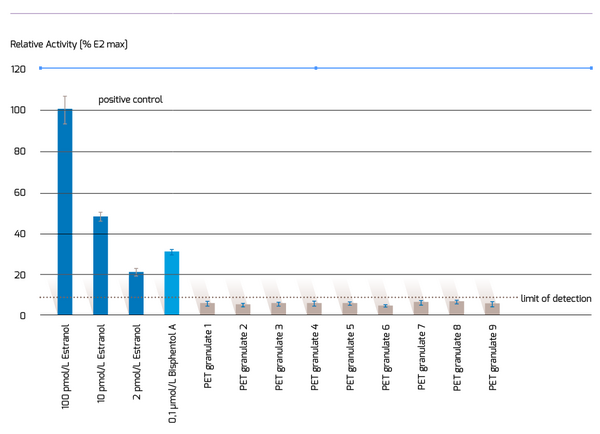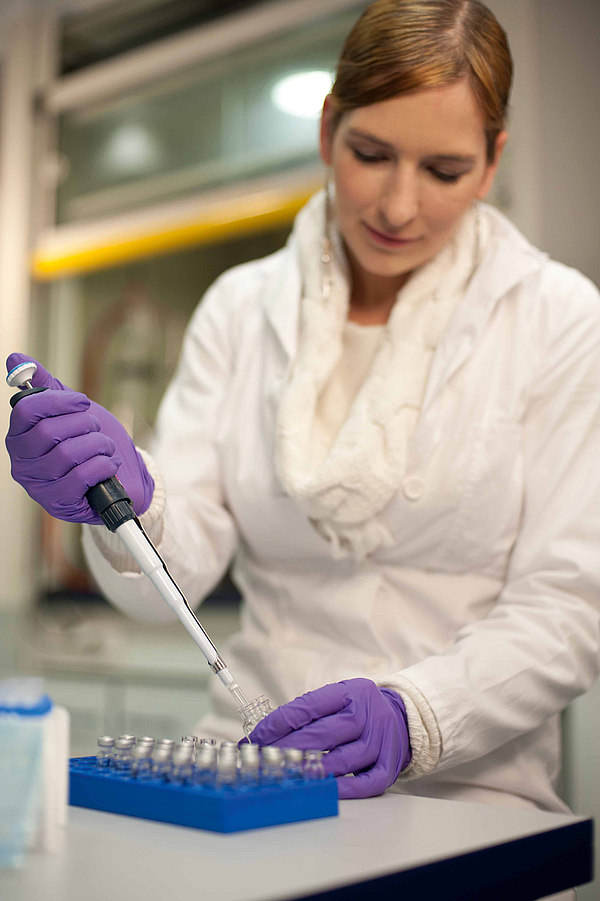

For many years, PET bottles have been suspected of containing hormonally active substances that could affect the human organism. However, this suspicion is based on analyses of mineral water, whereas the hormonal effects of PET bottles themselves have, so far, never been examined. An OFI research team has finally undertaken this task, with reassuring results. In the context of a research project, 40 different PET samples were tested by means of reliable, high-sensitivity methods – with undramatic results.
Female hormones in mineral water
It was a major media uproar: in 2009, scientists at Frankfurt University detected alarmingly strong hormonal activity in mineral water. The German researchers employed bioassays to demonstrate that components of the mineral water samples mimicked the female sex hormone oestrogen /1/. ‘We realised that, in terms of hormones, mineral water has about the same quality as waste water in sewage treatment plants’ /2/. With such statements, the researchers set the alarm bells ringing.
But where do these hormones come from? In the case of waste water from sewage treatment plants, the answer is straightforward: besides natural hormones from human urine, synthetic oestrogens from birth control pills also play a significant role – which in extreme cases, can lead to the feminisation of entire fish populations. However, the high levels of oestrogenicity in mineral water cannot be explained as easily. It should be obvious in this case that hormones from human or animal excrement can be ruled out, and at first glance, there does not seem to be any plausible source of hormones in mineral water.
Have PET bottles been falsely blamed?
Various assumptions about possible hormone sources were then made. PET bottles, which were used for the majority of the mineral waters tested, were regarded as the likely suspects, which was possibly influenced by the negative image of ‘plastics’ in general. Certain components of plastics (e.g. certain plasticisers or starting materials for polymerisation processes) can have a structure similar to the natural oestrogen 17ß-oestradiol, and the human hormone receptors can therefore mistake them for hormones. The researchers were unable to corroborate their suspicion in experiments because no tests on the bottles themselves had been conducted, and on the basis of the available results, conclusions as to the material were possible only to a very limited extent.
Still, voicing the suspicion was enough to cause outright panic: numerous media articles and NGO mailings warned against the use of PET bottles, neglecting to mention the fact that their warnings were based on mere assumptions, as no analyses on the bottles themselves were available. The study did mention some other potential sources as well, such as disinfectant residues, or contaminated spring water, which, however, was ignored in the media coverage. It was a difficult situation for the beverages industry, particularly manufacturers of PET bottles. It was impossible at that time to test the bottles directly in order to put an end to speculation as no reliable methods of analysis had yet been developed.
The traditional chemical analyses are reliable and very precise as far as the detection of known hormonally active substances such as bisphenol A and phthalates is concerned, but they do not cover hormonally active substances that are still unknown. For the majority of substances that can migrate from the PET bottle into the filling substance, no data on possible hormonal activity are available. The existing chemical screening procedures could thus not contribute to refuting the allegations made.

Figure 1: Results from the in-vitro screening of nine PET granulate samples for estrogen activity by cell culture tests (hER CALUX Assay): The positive controls 17 estradiol (natural estrogen) and Bisphenol A already show a significant estrogen activity at very low concentrations. In the extracts of the PET-granulates, however, no endocrine activity could be detected.
New analysis methods permit detection
More than five years ago, OFI began to study analysis methods for detecting hormonally active substances in food contact materials. Dr. Christian Kirchnawy (the scientific project manager at OFI) and his team have finally developed and validated a reliable procedure for the detection and identification of hormonally active substances.
The OFI researchers combine chemical trace analysis by means of GC-MS/FID and HPLC-MS3 with biological tests with human cells. Human cells that are cultivated in tissue culture dishes can be used for simulating the effects of hormones in the human organism. If a hormone binds to the corresponding hormone receptor, this activates a certain gene – a mechanism that also works in cell culture assays. In the human body, the hormones activate genes that trigger typical bodily reactions to the hormone. In the case of oestrogen, they may cause the growth of female breasts.
In the cell culture assay, however, the luciferase gene was introduced, which produces the bioluminescence of fireflies and can be very easily detected by means of genetic engineering methods. If a hormone or other hormonally active substance binds to the hormone receptor, a luminescence reaction is indirectly triggered. This cannot be observed with the naked eye, but can be easily and reliably identified with high-sensitivity laboratory instruments. This permits the detection not only of known hormonally active substances such as bisphenol A (BPA) or phthalates but of all substances that bind to the human hormone receptors for oestrogens, androgens or thyroid hormones.

OFI says no cause for alarm:
PET bottles free of hormones
So far, 40 different PET materials have been analysed at OFI, ranging from granulates to preforms and complete bottles, with recycling proportions between 0% and 100%. The results are definitely reassuring: no hormonal activity was detected in any of the samples tested – even though the sensitivity of the tests has undergone further improvement since the mineral water study conducted at Frankfurt University. In addition, the test methods have been expanded to include further hormonal axes (male sex hormones and thyroid hormones) which are currently in the focus of the WHO and the European Commission.
‘In view of our results it is very unlikely that PET bottles are the cause of the high oestrogen activity in mineral water that has been detected in various studies’, explains Dr. Christian Kirchnawy. However, he cannot give the all-clear for all plastics. In a large-scale screening of over 300 packaging samples, hormonal activity was in fact detected in individual samples, for instance caused by certain hormonally active metabolites of antioxidants. But all in all, the extent of hormonally active substances is considerably smaller than was suspected after the study on mineral water samples. Dr. Kirchnawy also points to another aspect: ‘Even if hormonal activity has been detected, this does not necessarily mean that the plastic in question actually poses a risk. Through the food we eat, considerably larger amounts of hormonally active substances enter the organism, e.g. phyto-oestrogens or natural hormones in meat.’
The comPETence center provides your organisation with a dynamic, cost effective way to promote your products and services.

magazine
Find our premium articles, interviews, reports and more
in 3 issues in 2025.






